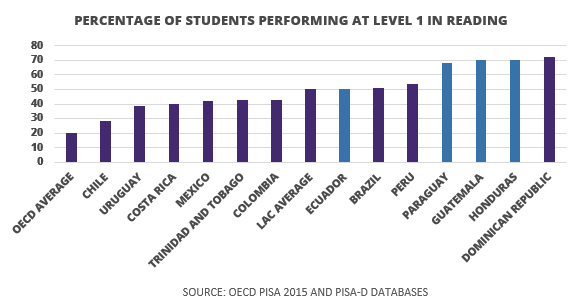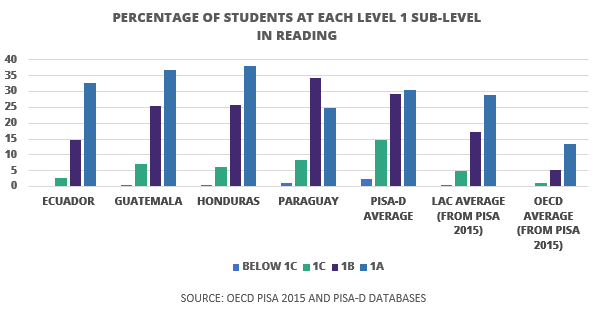 What Do We Know About Latin America’s Lowest-Performing Education Systems?
What Do We Know About Latin America’s Lowest-Performing Education Systems?
Data from the recent PISA for Development (PISA-D) survey offers a new window into academic performance and learning environments in lower-income countries in Latin America, providing a more complete overview of the state of education in the region. The data, however, paints a troubling picture of the state of learning environments in Latin American countries. Schools are plagued by high rates of absenteeism, low levels of parent involvement, and lack of resources, all of which are detrimental to students’ ability to learn and grow.
Every three years, some 80 countries collaborate to compare how well their students perform in school. The Program for International Student Assessment (PISA), an initiative of the OECD, is an international student assessment that evaluates 15-year-old students in reading, math, and science. Since 2000, it has shed light not only on levels of academic performance across these countries, but also on the factors that impact performance, such as socioeconomic levels, teacher and school characteristics, etc.
Recognizing the need to include a larger and more diverse group of countries, the OECD launched PISA for Development (PISA-D), which uses enhanced PISA survey instruments that are more relevant for the contexts found low- and middle-income countries. In December 2018, the OECD released the results for the first PISA-D examination, which included four Latin American countries: Ecuador, Guatemala, Honduras, and Paraguay.
Combined with the data from previous PISA reports, the PISA-D results paint a troubling picture of the state of learning environments in Latin American countries. What are the key takeaways from these results?
The introduction of the four LAC PISA-D countries into the PISA databases is a welcome development for policy makers.
First, the good news: the addition of data from Ecuador, Guatemala, Honduras, and Paraguay means that there are now thirteen LAC countries in the database. The region has a far higher rate of participation than any other region outside North America and Europe, whose participating countries are almost all OECD member countries. The trend in Latin America toward participating in international student achievement studies inspires optimism and indicates that there is a regional consensus around the benefits of participation. Additionally, filling out the LAC map in PISA also gives us a more complete picture of the effects of education policy in the region. The addition of the four LAC PISA-D countries is especially important because they represent lower-income parts of the region that were missing from the previous data. PISA data now includes every Spanish-speaking country in South America except Bolivia and Venezuela, as well as every Spanish-speaking country in Central America except El Salvador and Nicaragua.
More than half of the students in PISA-D score below the OECD’ recognized baseline for minimum level of performance.
While their participation in the study is a step in the right direction, the data in the PISA-D report on the LAC participants gives plenty of cause for concern. In the data from the PISA 2015 report, approximately half of the students in LAC countries scored at Level 1 or below in reading, meaning they score below the minimum level of competency as defined by PISA for students in lower secondary schools. In LAC PISA-D countries, roughly 65% of students score at Level 1 or below, making a more granular approach with sub-levels within Level 1 necessary.

PISA-D separates Level 1 scores into three distinct sub-levels: 1a, 1b, and 1c, with 1a being the strongest and 1c being the weakest. In the reading test, students at Level 1a can understand explicitly stated information and main themes, as well as make connections to familiar topics. Level 1b students can retrieve information from titles or simple lists, but fail to understand texts of more than a few sentences. Level 1c students struggle to comprehend even explicitly stated information in short, simple texts. It is concerning that in the LAC PISA-D countries, large proportions of students fall into the worse-performing sub-levels in Level 1. Paraguayan students’ scores are especially concerning, with more than two in five students performing at Level 1b or below (see graph below).

On the math part of the test, the sub-levels are even more necessary. An alarming average of 84% of students scored at Level 1 or below in LAC PISA-D countries, higher than the PISA 2015 LAC average of 70% and the OECD average of 23%. Nearly three quarters of the 84% of LAC PISA-D students who perform at Level 1 performed at Level 1b or below, meaning that a clear majority of the students often fail to perform routine tasks with an obvious course of an action and can follow only simple instructions.
One surprising finding from the results came from Ecuador, where students’ scores are on par with the LAC regional average and higher than the lower-middle income country average from the PISA 2015 report. This performance is even more impressive when public expenditure on education is considered. Ecuador spends a similar amount of public resources per student on education as Paraguay and still outperforms every PISA-D country by substantial margins.
Rates of school absenteeism are troublingly high throughout Latin America, even when compared to the other low-performing PISA-D countries.
It is worrisome that the four Latin American countries in PISA-D demonstrate the four highest percentages of students who reported having skipped a whole day of school at least once within two weeks of the PISA-D survey. Paraguay is again the most troubling case, with over half of its students skipping a school day at least once in the two weeks prior to the PISA test. Adding to the concern is the 17% of students in Paraguay and Guatemala who report having missed school for more than three months in a row.
This trend is reflected in the alarmingly high average student absenteeism rates among LAC countries even when compared to other PISA-D countries: 45% of students in LAC PISA-D countries and 40% of students in other LACs reported having skipped a day of school in the two weeks leading up to the survey.
Lack of resources and basic amenities in Latin American schools impedes the ability to learn.
Basic school infrastructure in the LAC PISA-D countries is in dramatic need of repair. Amenities that keep students healthy and able to learn are not available for many students in Latin American schools, with the vast majority of students attending schools without a first aid room, and most students in Ecuador and Guatemala lacking access to a cafeteria. Fewer than half of the students in the LAC PISA-D countries have fully functional indoor plumbing at their schools, and most students in Honduras and Paraguay don’t have safe drinking water. Additionally, more than half of the students in all PISA-D countries except Ecuador attend schools that don’t have access to internet connection or computers for teachers.
Neither parents nor teachers are as present as they need to be in students’ educational experiences in the LAC PISA-D countries.
Student learning requires a supportive presence from both parents and teachers. One measure of parental involvement in their children’s education is attendance at parent-teacher conferences, a metric that remains low in PISA-D countries. The four LAC participants have above average parental attendance among PISA-D countries, but attendance is still below 50% in all countries except Guatemala.
The problem of teacher absenteeism plagues PISA-D countries as well, with the clear majority of PISA-D students having experienced teacher absenteeism at least once in the two weeks prior to the survey[. Teacher absenteeism is especially prevalent in the LAC PISA-D countries, where students report even higher rates of cancelled classes than the rest of the PISA-D countries—an indication that Latin American students are receiving drastically less class time than what is required.
Conclusions
The PISA-D report represents a positive movement towards shedding light on learning outcomes in previously under-examined, lower-income countries. The willingness to measure student performance and collect data on learning environments is the first step towards improving education systems that are failing their students. The PISA-D data gives policy makers the opportunity to identify problems in their countries’ systems, especially those related to leaning environments that impede student achievement, and design solutions that can significantly improve learning
0 Comments